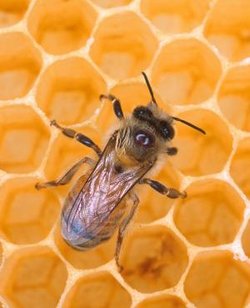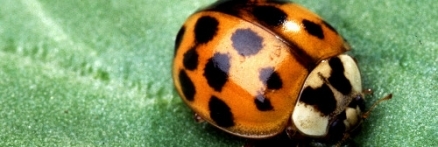Beneficial insects (Agricultural & Resource Economics)
Contents
Beneficial insects
The Nine-spotted Ladybug used to be one of the most commonly encountered ladybugs throughout its historic range. In recent years, it has declined to the point which it is now only infrequently encountered.
Beneficial Bugs
"Bugs" have gotten a bad reputation! A few nasty creatures seem to have given the whole class of organisms a bad name. Before you decide to exterminate that creature crawling around on your plants or patio, find out what it is. It may be your partner in plant protection! A pocket field guide to insects is a good investment if you want to learn more about the insect species that frequent your yard. These picture guides help you identify the organisms and determine the appropriate control methods, if needed.
How to recognize the good guys.
 Bee. Source: USDA
Bee. Source: USDA Unless you are familiar with insects, there is no easy way to determine if the insect is a beneficial species or a damaging one. To complicate matters further, many species go through drastic changes in their lives where the immature forms such as caterpillars may actually damage your plants, but, eventually, these damaging caterpillars turn into gorgeous butterflies you want to attract!
Common beneficial insects you are likely to see in your yard include:
- the ladybug beetle which feeds on aphids,
- dragonflies and damselflies which are tremendous mosquito predators, and
- lacewings which feed on soft-bodied insects such as aphids.
Hundreds of other species may be there as well, but some of them such as parasitic wasps are so small that you probably won’t see them.
How to encourage beneficial insects in your yard.
Unfortunately, most insecticides kill beneficial insects as well as pests. Consider the following before spraying for control.
1. Identify the pest before applying any control method. Field guides are available at most bookstores or public libraries. Your local Cooperative Extension Service office may have fact sheets on common insect pest identification.
2. Determine how much damage is being done to the plant. Depending on the size of the plant and the amount of damage, no control may be needed. A few nibbled leaves on a large plant do not necessarily require control.
3. Can control be achieved with non-chemical methods? Often, it is quicker and more effective to physically remove the pests from the plants. This works best with large insects such as tomato hornworms.
4. If chemical control is needed, apply it when the air is still and other insects are less active. Target the spray at the offending organisms to reduce contact with other species.
5. Increase the diversity of plantings in your yard. Diversity of plants will help lead to diversity in insect and other wildlife populations. Several beneficial insects favor parsley and dill for their nectar. In addition, these plants provide food for the larvae of the eastern black swallowtail butterfly. Plant diversity also will provide habitat needed for overwintering.
6. Remember: complete eradication is not compatible with maintaining natural predator populations. Beneficial insects need something to eat! Maintaining low, yet nondestructive, populations of pests will help maintain populations of the good guys.
For more information on Backyard Conservation practices, contact your local conservation district or the Natural Resources Conservation Service. Or call 1-888-LANDCARE (toll free) for a free colorful Backyard Conservation booklet and tip sheets.
Backyard Conservation is a cooperative project of
Natural Resources Conservation Service
Wildlife Habitat Council
National Association of Conservation Districts
